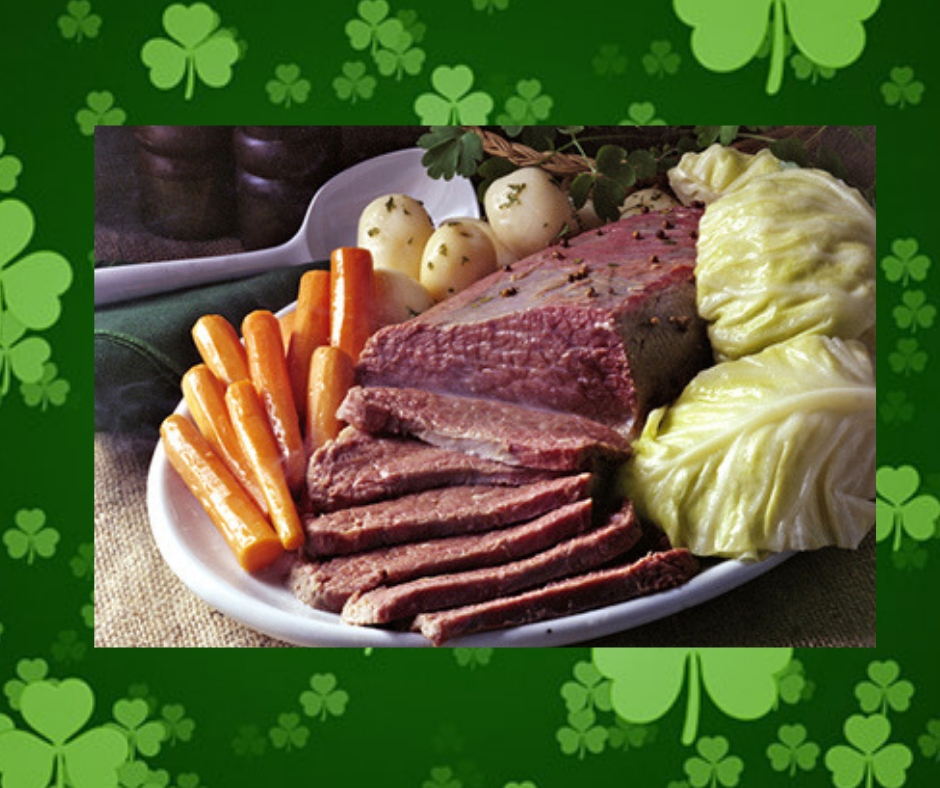Corned Beef and Cabbage, Synonymous with St. Patrick's Day
TEXARKANA, Ark. –
Corned Beef and Cabbage seem to be synonymous with St. Patrick’s Day. As St. Patrick’s Day evolved into a celebration of Irish heritage and nationality for Irish-Americans, corned beef and cabbage became a holiday tradition for consumers across the nation.
In the 18th century, when large numbers of Irish immigrants came to the U.S., they found salted beef brisket was cheap in the States, and were quick to adapt from corned pork to corned beef and nutrient-dense cabbage, which was readily available and affordable. Combining the two became a staple for working classes across the country.
Corned beef, created as a form of curing; has nothing to do with corn. The meat was dry-cured in coarse "corns" of salt. Pellets of salt, some the size of kernels of corn, were rubbed into the beef to keep it from spoiling and to preserve it.
Today brining, the use of salt water, has replaced the dry salt cure, but the name "corned beef" is still used, rather than "brined" or "pickled" beef. Commonly used spices that give corned beef its distinctive flavor are peppercorns and bay leaf.
Although corned beef is cured in a brine, food safety must still be followed. When buying uncooked corned beef in a pouch with pickling juices which has a "sell-by" date or no date, store it for 5 to 7 days in the refrigerator, unopened. If you buy products with a "use-by" date, you may store it unopened in the refrigerator until that date.
If purchasing to use later, an uncooked corned beef brisket may be frozen for 1 month for best quality if you drain and re-wrap it, due to the salt that encourages rancidity and texture changes. The flavor and texture will diminish with prolonged freezing, but the product is still safe. After cooking, corned beef may be refrigerated for about 3 to 4 days and frozen for about 2 to 3 months for best quality.
Corned beef is made from less tender cuts of beef like the brisket, rump or round and requires long, moist cooking. There are various methods for cooking corned beef.
OVEN: Set the oven for 350 °F or no lower than 325 °F. Place cur of beef fat-side up. Barely cover the meat with water, about 1 inch, and keep the container covered throughout the cooking time. Allow about 1 hour per pound.
OVEN COOKING BAG: Preheat the oven to 325 °F. Add 1 tablespoon of flour to the bag plus one half cup water. Follow the manufacturer's instructions for closing the bag. For a 2 to 3-pound corned beef brisket, cook for 2 and one half to 3 hours. For a 3 to 5-pound corned beef brisket, cook for 3 to 3 and one half hours.
STOVE: Place brisket fat-side up in a large pot and cover it with water. Bring the water to a boil; then reduce the heat and simmer, allowing about 1 hour per pound. Vegetables may be added during the last 20 to 30 minutes of cooking. Cook vegetables to desired tenderness.
SLOW COOKER: If using root vegetables, such as potatoes and carrots, put them in the bottom of slow cooker. Place brisket on top of vegetables (if using) or in bottom of cooker. Add about one and one half cups of water or enough to cover meat. Cover and cook on high setting for the first hour of cooking. Then cook for 10 to 12 hours on the low setting or 5 to 6 hours on high. Cabbage wedges may be added on top of the brisket during the last 3 hours of cooking.
If your corned beef is still pink in color after cooking, it does not mean it is not done. It is due to the nitrite used in the curing process. This fixes pigment in the meat and affects the color. It is safe to eat, just use a food thermometer to assure the corned beef reaches a safe minimum internal temperature of 145 °F or above.
Regardless of cooking method you choose, allow the brisket to stand for about 20 minutes after removing from the heat. This will make it easier to slice. It is best sliced diagonally across the grain of the meat.
Leftover corned beef should be refrigerated within 2 hours of cooking and can be eaten safely for up to 4 days. To reheat leftover corned beef, the meat should be brought up to 165 degrees before eating.
For more information, contact the Miller County Extension Office, 870-779-3609 or visit us in room 215 at the Miller County Courthouse. We're online at cdue@uada.edu, on Facebook at UAEXMillerCountyFCS/CarlaDue, on Twitter @MillerCountyFCS or on the web at uaex.uada.edu/Miller.
By Carla Due
County Extension Agent - FCS
The Cooperative Extension Service
U of A System Division of Agriculture
Media Contact: Carla Due
County Extension Agent - FCS
U of A Division of Agriculture
Cooperative Extension Service
400 Laurel Street, Suite 215 Texarkana AR 71854
(870) 779-3609
cdue@uada.edu
The Arkansas Cooperative Extension Service is an equal opportunity institution. If
you require a reasonable accommodation to participate or need materials in another
format, please contact your County Extension office (or other appropriate office)
as soon as possible. Dial 711 for Arkansas Relay.
Pursuant to 7 CFR § 15.3, the University of Arkansas System Division of Agriculture
offers all its Extension and Research programs and services (including employment)
without regard to race, color, sex, national origin, religion, age, disability, marital
or veteran status, genetic information, sexual preference, pregnancy or any other
legally protected status, and is an equal opportunity institution.
